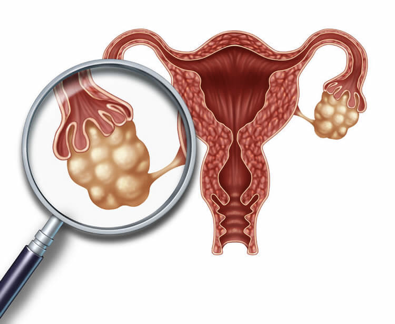
Polycystic ovary syndrome: Everything you need to know..
What is PCOS?
Polycystic ovary syndrome (PCOS) is one of the most common hormonal endocrine disorders affecting 27 percent of women, many of whom do not have a diagnosis. It involves cysts in the ovaries, high levels of male hormones, and irregular periods. Around 70 percent of ovulatory fertility issues are related to PCOS.
PCOS affects a woman’s ovaries, the reproductive organs that produce estrogen and progesterone (hormones that regulate the menstrual cycle), ovaries also produce a small amount of male hormones called androgens.
The ovaries release eggs to be fertilized by a man’s sperm. The release of an egg each month is called ovulation. Follicle-stimulating hormone (FSH) and luteinizing hormone (LH) control ovulation. FSH stimulates the ovary to produce a follicle — a sac that contains an egg — and then LH triggers the ovary to release a mature egg.
PCOS is a “syndrome,” or group of symptoms that affects the ovaries and ovulation. Its three main features are, cysts in the ovaries, high levels of male hormones and irregular or skipped periods.
In PCOS, many small, fluid-filled sacs grow inside the ovaries. The word “polycystic” means “many cysts.”
These sacs are actually follicles, each one containing an immature egg. The eggs never mature enough to trigger ovulation.
Some women with PCOS have cysts on their ovaries. That’s why it’s called “polycystic.” But the name is misleading because many women with PCOS don’t have cysts.
Hormones and PCOS:
Estrogen and progesterone levels are lower than usual, while androgen levels are higher than usual. Extra male hormones disrupt the menstrual cycle, so women with PCOS get fewer periods than usual.
The 3 main features of PCOS are, irregular periods, excess androgen and polycystic ovaries.
If you have at least 2 of these features, you may be diagnosed with PCOS.
What causes PCOS?
The exact cause of PCOS isn't known. Doctors believe that high levels of male hormones prevent the ovaries from producing hormones and making eggs normally. They believe it stems from factors such as genes (runs in families), insulin resistance (Up to 70 percent of women with PCOS have insulin resistance), and higher levels of inflammation in the body (excess inflammation linked to higher androgen levels).
Common symptoms of PCOS:
Some women start seeing symptoms around the time of their first period. Others only discover they have PCOS after they’ve gained a lot of weight or they’ve had trouble getting pregnant. More than half of PCOS women do not have any symptoms.
The most common PCOS symptoms are:
- Irregular periods. Some women with PCOS get fewer than eight periods a year.
- Heavy bleeding. the periods you do get can be heavier than normal.
- Hair growth. More than 70 percent of women with this condition grow hair on their face and body. Excess hair growth is called hirsutism.
- Acne. Male hormones can make the skin oilier than usual and cause breakouts on areas like the face, chest, and upper back.
- Weight gain. Up to 80 percent of women with PCOS are overweight or obese.
- Male-pattern baldness. Hair on the scalp gets thinner and fall out.
- Darkening of the skin. Dark patches of skin can form in body creases like those on the neck, in the groin, and under the breasts.
- Headaches. Hormone changes can trigger headaches in some women.
How PCOS affects your body?
There are several health risks associated with PCOS. Having higher-than-normal androgen levels can affect your health, such as;
- Infertility, PCOS is one of the leading causes of infertility in women.
- Metabolic syndrome, Up to 80 percent of women with PCOS are overweight or obese.
- Abnormal uterine bleeding
- High blood pressure
- Sleep apnea, Sleep apnea is more common in women who are overweight, especially if they also have PCOS. The risk for sleep apnea is 5 to 10 times higher in obese women with PCOS than in those without PCOS.
- Endometrial cancer
- Depression and anxiety.
How PCOS is diagnosed?
Doctors typically diagnose PCOS in women who have at least two of these three symptoms; excess androgen levels, irregular menstrual cycles or cysts in the ovaries. A pelvic exam, blood tests, and ultrasound can confirm the diagnosis.
Pregnancy and PCOS:
Between 70 and 80 percent of women with PCOS have fertility problems. This condition can also increase the risk for pregnancy complications.
Women with PCOS are twice as likely as women without the condition to deliver their baby prematurely. They’re also at greater risk for miscarriage, high blood pressure, preeclampsia, premature delivery and gestational diabetes.
However, women with PCOS can get pregnant using fertility treatments that improve ovulation.
References:
1- https://www.healthline.com/health/polycystic-ovary-disease#when-to-see-a-doctor
2- https://www.mayoclinic.org/diseases-conditions/pcos/symptoms-causes/syc-20353439
3- https://www.nhs.uk/conditions/polycystic-ovary-syndrome-pcos/
4- https://www.medicalnewstoday.com/articles/265309.php#pregnancy-and-menopause